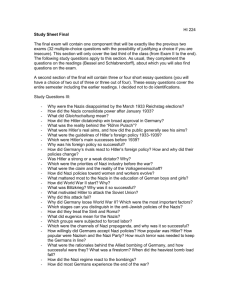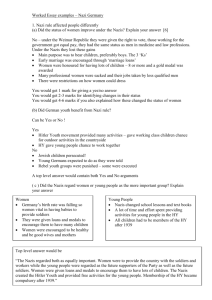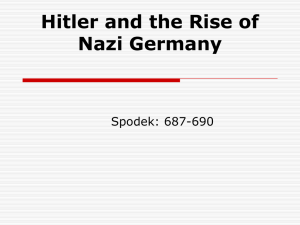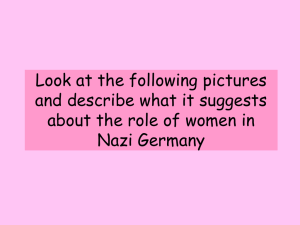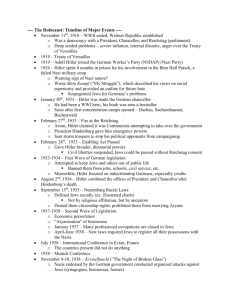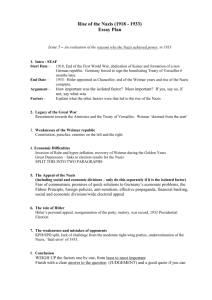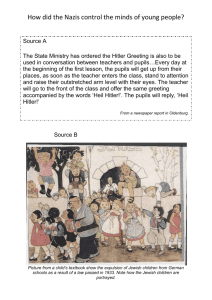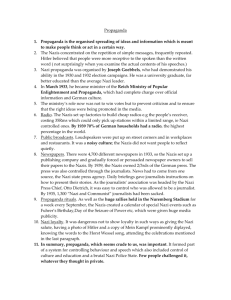The German Labour Front - Watford Grammar School for Boys Intranet
advertisement
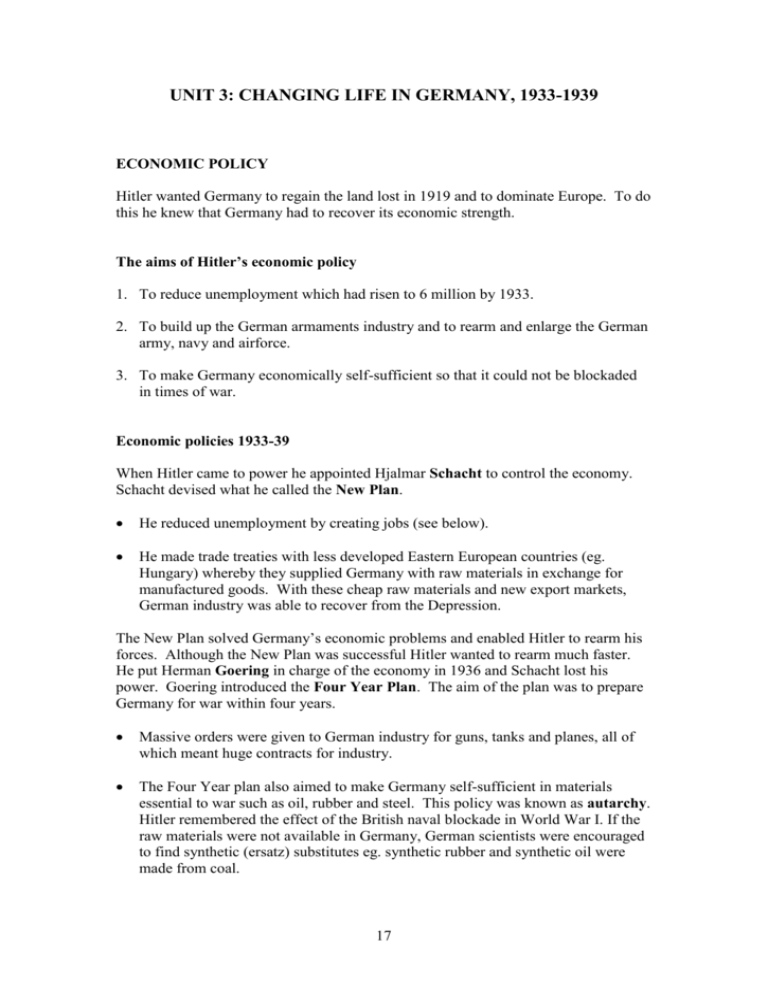
UNIT 3: CHANGING LIFE IN GERMANY, 1933-1939 ECONOMIC POLICY Hitler wanted Germany to regain the land lost in 1919 and to dominate Europe. To do this he knew that Germany had to recover its economic strength. The aims of Hitler’s economic policy 1. To reduce unemployment which had risen to 6 million by 1933. 2. To build up the German armaments industry and to rearm and enlarge the German army, navy and airforce. 3. To make Germany economically self-sufficient so that it could not be blockaded in times of war. Economic policies 1933-39 When Hitler came to power he appointed Hjalmar Schacht to control the economy. Schacht devised what he called the New Plan. He reduced unemployment by creating jobs (see below). He made trade treaties with less developed Eastern European countries (eg. Hungary) whereby they supplied Germany with raw materials in exchange for manufactured goods. With these cheap raw materials and new export markets, German industry was able to recover from the Depression. The New Plan solved Germany’s economic problems and enabled Hitler to rearm his forces. Although the New Plan was successful Hitler wanted to rearm much faster. He put Herman Goering in charge of the economy in 1936 and Schacht lost his power. Goering introduced the Four Year Plan. The aim of the plan was to prepare Germany for war within four years. Massive orders were given to German industry for guns, tanks and planes, all of which meant huge contracts for industry. The Four Year plan also aimed to make Germany self-sufficient in materials essential to war such as oil, rubber and steel. This policy was known as autarchy. Hitler remembered the effect of the British naval blockade in World War I. If the raw materials were not available in Germany, German scientists were encouraged to find synthetic (ersatz) substitutes eg. synthetic rubber and synthetic oil were made from coal. 17 Hitler never achieved his aim of making Germany completely self-sufficient by the time war broke out in 1939, but perhaps Germany would have been defeated more quickly if autarky hadn’t been introduced. The reduction in unemployment In his election campaigns Hitler had promised to provide ‘bread and work’ for the German people. This was a promise he could not afford to break. In 1933 there were six million Germans unemployed. By 1939 this figure had come down to 300,000. How did the Nazis do this? 1. The Nazis created jobs through government spending on Public Works Schemes. Millions of people were ordered to join the Reich Labour Service and sent to work wherever the government told them to go. They would often work on building motorways (autobahns), hospitals, schools and improving agriculture. Huge public buildings were constructed including a new Olympic stadium for the 1936 Olympic Games in Berlin. Such buildings not only created jobs but impressed people. 2. Rearmament also created jobs. 3. More men were recruited into the army. When Hitler came to power in 1933 the army was limited to 100,000 men by the Treaty of Versailles. By 1938 the figure had risen to 900,000 men. The German Labour Front In 1933 the Nazis banned trade unions because trade unionists tended to support the Socialist and Communist Parties, the enemies of the Nazis. In their place the Nazis developed the idea of everyone working together for the good of the country. So they set up the German Labour Front. This Nazi organisation controlled all aspects of workers’ rights and conditions eg. wages, hours etc. Strikes, of course, were illegal. Workers found that their wages were kept low and that they were working longer hours. The workers expected some benefits and the German Labour Front set up two organisations to improve the lives of the workers. 1. The Beauty of Labour organisation tried to improve working conditions by, for example, improving safety standards, reducing noise levels in factories and introducing hot midday meals. 2. The Strength through Joy organisation was set up to provide workers with leisure activities when they were not working. These included film shows, concerts and excursions. Those who worked hardest could be rewarded with a cruise on a Strength through Joy ship. Another venture by this organisation was the development of the Volkswagen, the people’s car. Workers were encouraged to start saving for one. 18 Behind all these improvements was an attempt to control people’s working lives and leisure time, and to convince the workers of the need to work harder and longer for less money. They were told that they were helping to build a great and powerful Germany. SOCIAL POLICIES: YOUNG PEOPLE Hitler realised that any opposition to the Third Reich would come from older people, who were set in their ideas. With children it would be different. They could be indoctrinated from babyhood with Nazi ideas, and grow up to be good Nazis who would never question Hitler’s policies. Education The man chosen to run German education was Bernard Rust, a teacher who had been sacked in 1930 for ‘instability of mind’. His first action was to ‘Nazify’ the teachers. Any teachers known to be anti-Nazi were sacked, and the rest were sent on courses, and to camps, to be ‘trained’ in Nazi ideas. Rust, like Hitler believed that the whole purpose of education was to create Nazis. School timetables were changed so that young people were constantly exposed to Nazi ideas. Education was to produce boys with military skills and girls with domestic skills. Children were taught that the German (Aryan) race was superior to any other; that Hitler was a great leader whose actions and ideas were never to be questioned; and that Jews were evil and not fit to be German citizens. The school timetable included new subjects that Hitler considered important eg. Race Studies. Other subjects such as Maths, History, Geography and Science were to be taught either in a ‘military’ way or to show how superior the Aryan race was. Physical education was increased so that boys would be fitter to be better soldiers and girls to be better mothers. History books were rewritten to show how dreadful the Jews were and how unfair the Treaty of Versailles was. There was no attempt to teach students to think for themselves. Hitler went further and set up special schools for boys. These were called Napolas and were set up to train the future Nazi leaders. They were run by ex-members of the SS. Athletics and courage were more important than academic ability. There is no doubt that most children became good Nazis, but educational standards did go down because teachers and parents were afraid to question what children were taught. Youth Movements The Nazis also believed it was important to control young people’s minds in their spare time. Children and young people were expected to join the youth movements which aimed to prepare boys for war and girls for motherhood. Boys joined the Hitler Youth at the age of 14. They wore uniforms, learned to shoot guns and read 19 maps, went to camp and on long marches. In 1936 membership was made compulsory. The League of German Maidens was the girls’ version of the Hitler Youth. It also organised camping and hiking, but to make girls fit enough to be strong mothers. They were taught about health matters and motherhood in preparation for their future role in life. The Nazis were very critical of young women who smoked, wore trousers or put on makeup because they were not concentrating on being ‘good’ mothers. Youth gangs However, even in Nazi Germany, there were young people who rebelled. Youth gangs, such as the Edelweiss Pirates, took pleasure in beating up Hitler Youth members, while others enjoyed listening to American Negro jazz, and growing their hair long. But these groups were in a minority and the state took very severe measures against them, even to the extent of hanging them during the Second World War. SOCIAL POLICIES: WOMEN AND THE FAMILY The Nazis had very clear ideas on the role of women in society. A woman’s duty was clearly seen as being child bearer of a pure Aryan race, and as a supporter of her husband. Women had a role which was entirely separate from men. A woman’s place was in the home, having children and caring for her family. The Nazi slogan ‘Kinde, Kirche, Kuche’ (Children, church and cooking) summed up the Nazis’ view of women. As a result the lives of many women changed: Because of Nazi policies, women, who had obtained equal rights under the Weimar Republic, now found they were being discriminated against, especially in the workplace. The first to suffer were women who had professional jobs. Doctors and civil servants were sacked. The number of women teachers declined. From 1936 women were not allowed to be judges or lawyers, or even to sit on juries because it was felt that they couldn’t make logical decisions without being too emotional. Women had played an active part in politics during the Weimar period. One-tenth of Weimar MPs had been women but under the Nazis women were not allowed to take part in politics. Although the Nazi Party had female organisations, women never had any real political power. They were banned from positions of leadership in the Party. The Nazis were worried by the decline in the birth rate and launched a massive propaganda campaign to promote motherhood and large families. The government offered marriage loans to women who gave up work in order to get married. These loans did not have to be repaid if the woman had at least four children. Women were also awarded medals for having children. The gold 20 ‘Honour Cross of the German Mother’ was given to those who had eight. Contraception and abortion were made illegal. To improve women’s fertility they were encouraged to stop smoking, stop slimming and to do sport. Propaganda campaigns were launched to persuade women to bring up their children as loyal Nazis who idolised the Fuhrer and joined the Nazi youth organisations. Nazi policies were only aimed at healthy Aryan women. So Jews could not get marriage loans. Women with hereditary diseases were sterilised. How successful were Nazi policies aimed at women? Although professional women lost their jobs, women were still needed in industry especially when Germany started to recover from the Depression. By the late 1930s there was a shortage of labour in Germany. Women were needed in the factories. By 1939 there were more women in jobs than there had been in 1933. The birth rate rose in the period 1933-39. Although the Nazis said that they were encouraging traditional family life many of their other policies undermined the family. Children were now so busy and active, they spent little time with their family. Also, mothers found it increasingly difficult to discipline young boys who were taught to believe that women were to serve men. SOCIAL POLICIES: THE CHURCHES The ideas of the Nazis were opposed to the beliefs and values of the Christian Church. The Nazis glorified strength, violence and racial superiority while Christianity taught love, forgiveness and respect for all people. Germany was a Christian country and the Nazis could not ignore the Churches. Most Germans, about two thirds, were Protestants, whereas most of the other third were Roman Catholics. When Hitler came to power in 1933 the Churches were willing to give him their support despite the violence associated with Nazism. There were three reasons for this: 1. The Nazis said that they supported the family and old fashioned values. 2. The Nazis were opposed to communism. The Churches feared the communists because they wanted to destroy Christianity. 3. Hitler set out to gain the support of the Churches. 21 The Roman Catholic Church In 1933 Hitler signed the Concordat with the Pope. This agreement said that the Catholic Church would be left alone by the Nazis as long as the Church stayed out of politics. But Hitler had no intention of keeping his promises to the Pope. After using the support of the Centre (Catholic) Party to get the Enabling Act through the Reichstag (see Unit 2), Hitler began to harass and arrest Catholic priests who were suspected of being anti-Nazi. Catholic schools were brought under the control of the Nazis so that Catholic children could be indoctrinated with Nazi propaganda. Catholic youth organisations were banned because many parents preferred to send their children to the Catholic Youth rather than the Hitler Youth. In 1937 the Pope attacked the Nazi system in a famous statement (encyclical) called ‘With Burning Anxiety’. But the Nazi persecution of priests continued and many were put in concentration camps because of their criticism of the Nazi government. The Catholic Church rarely openly opposed the Nazi government. Cardinal Galen, however, publicly attacked Nazi policies as early as 1934 and in 1941 he revealed that the Nazis were secretly killing mentally and physically handicapped people. His statement was read from the pulpits of Catholic Churches throughout Germany and he led a campaign which made Hitler call a halt to the euthanasia programme. The Protestant Churches Hitler united all the Protestant Churches together into one church under the leadership of a pro-Nazi called Muller. He was given the title of Reich Bishop and the Church he led became known as the German Christian Church. It adopted Nazi-style uniforms, salutes and marches. Many Germans were quite happy to be German Christians but some opposed Hitler and formed an alternative ‘Confessional Church’. Many of the ministers of the Confessional Church were sent to concentration camps. One of these was Martin Niemoller, a prominent critic of the Nazis. While in prison he was visited by the prison chaplain who asked him, ‘But brother! Why are you in prison?’ Niemoller replied, ‘And brother, why are you not in prison?’ Protestant Church schools and youth clubs suffered the same fate as those of the Catholic Church. The German Faith Movement The Nazis tried to start a new religious movement of their own. It was based on adulation of Hitler as a new god. It rejected Christian values and included many pagan ideas. It did not receive much support from the mass of the German people. The Nazis never destroyed the Churches in Germany. They made it difficult for Christians to worship but the Churches remained open and services were held. Hitler did, however, succeed in his aim of weakening the Churches as a source of resistance to his policies. 22 PROPAGANDA AND CENSORSHIP Governments use propaganda to persuade people to think and behave in a certain way. The Nazis used propaganda to convince the German people that their policies were right for Germany. The Nazis also used censorship. They tried to prevent people hearing, reading or seeing anything that was critical of the Nazis. Propaganda and censorship were vital to the Nazis because they helped to make sure that most Germans supported Nazi ideas. Both were controlled by the Minister of People’s Enlightenment and Propaganda, headed by Joseph Goebbels. He was a genius at using propaganda to persuade people that Hitler and his ideas were right for them. Rallies and campaigns Rallies were held all over the country to show how popular Hitler and the Nazis were and to persuade people that Nazi Germany was powerful and great. An annual rally of the Nazi Party was held each year in Nuremburg. Music, lighting and banners were used as a backdrop for Hitler’s speeches. The 1936 Olympic Games in Berlin were used as a propaganda opportunity to show the superiority of the Third Reich. German athletes won more medals than any other country. Poster campaigns were a way of giving ideas and images an important place in people’s minds. Images of Hitler as a wise leader appeared in many poster campaigns. Radio Radio was relatively new and Goebbels realised how useful it could be to Nazi propaganda. Industry was encouraged to produce cheap radios that everyone could afford and by 1939 Germany had more radios per head of population than any other country in the world. All radio programmes were carefully controlled and Hitler’s speeches were frequently broadcast. The radios on sale in Germany were designed to have a short range. This meant that they could not pick up foreign stations and listen to alternative versions of the news. Radio sets were placed in cafes and factories and loudspeakers placed in the streets. 23 The press Non-Nazi newspapers and magazines were closed down or taken over. News was biased in favour of the Nazis and editors were told what they could print. As a result, newspaper sales went down because people found them repetitive and boring. Films The cinema was very popular in Germany and over 100 films were made each year. All film plots had to be shown to Goebbels before production started. Although some propaganda films were made, Goebbels believed that propaganda succeeded best if people were entertained. The German cinema, therefore continued to make comedies, love stories, thrillers and historical epics, which were all given a pro-Nazi slant. Books, theatre, art and music Many writers, composers and artists were persuaded or forced to create works in praise of Hitler and the Third Reich. Books written by Jews, Communists and anti-Nazis were banned. Many were destroyed in public book-burnings in 1933. Jazz music was banned because it was the music of black people (an inferior race). Much modern art was declared ‘degenerate’ and art galleries were forced to get rid of it. THE PERSECUTION OF THE JEWS Anti-Semitism (hatred of Jews) was an important Nazi belief. As soon as Hitler came to power in 1933 the persecution of the Jews started. The first act of the Third Reich against the Jews was to organise a boycott of Jewish shops and businesses in April 1933, with SA brownshirts standing outside Jewish shops discouraging people from entering. But it was not as successful as the Nazis had hoped. Six days later the Reichstag passed a law which banned all Jews from working for the civil service (government). But Hitler was forced by President Hindenburg to allow Jews who had fought, or who had a relative killed, in the First World War, to keep their jobs. 24 When Hindenburg died in 1934, the Nazis were able to increase their persecution of the Jews. They were banned from public parks, swimming pools, cinemas, theatres and restaurants. Things got even worse for the Jews in 1935, when at the massive Nuremberg rally, Hitler announced what became known as the Nuremberg Laws. There were two of these laws: 1. The Reich Citizenship Act which said that no Jew could vote or be elected to a government post. Jews were stripped of the right to be citizens of Germany. 2. The Law for the Protection of German Blood and Honour. Jews were defined as anyone with a Jewish grandparent, and forbidden to marry or have sexual relations with German citizens. The second of these two laws showed an important difference between the Nazis’ anti-Semitism, and how Jews had been persecuted before. The Nazis said that the Jews inherited their evil from previous generations and the evil was present in Jewish blood, whereas in the past Jews had been persecuted because of their religion. This difference was important because it meant the Jews could do nothing to escape persecution. In the past they had been able to save themselves by becoming Christians. In 1936, things became a little easier for the Jews because the Nazis hid all signs of persecution while the Olympic Games were being held in Berlin. But when the Games had finished, the Nazis returned to their persecution. In 1937, on secret orders from Heydrich, Jewish women who had had sexual relations with German citizens were sent to concentration camps. But it was the year 1938 when things were made even worse for the Jews. One reason for this was that the Third Reich was now united with Austria and the Nazis found they had many more Jews in their population. They were determined to deal with this ‘problem’. All Jewish parents had to add the name ‘Sara’ to their daughter’s name and ‘Israel’ to their son’s. All Jewish doctors and other professional people could only do business with other Jews. In November the persecution reached its height. A German embassy official was murdered in Paris by a young Jew. Immediately the Nazis organised a massive attack on Jewish shops, homes and synagogues. About 100 Jews died in SA attacks, and thousands of Jewish properties were destroyed. This event became known as Crystal Night because of all the broken glass on the German streets. Over 30,000 Jews were arrested and sent to concentration camps. The Nazis claimed it was an outburst of anger by ordinary people. In reality, however, it was organised by Goebbels. The persecution continued after Crystal Night. Goering confiscated all Jewish businesses, selling them cheaply to German businessmen. Jewish children were banned from German schools and universities. Jews were encouraged to emigrate, but without any of their possessions. 25 Why didn’t the Jews do something? This was difficult. Despite what the Nazis said, the Jews were a small percentage of the population (only 1%). Also, many Jews thought if they kept quiet then the persecution would, as it always had done in the past, go away. They were not to know the horrors that awaited them after 1941. The treatment of other minority groups The Gypsies were also persecuted by the Nazis. They were targeted because they were not Aryans and because of their travelling lifestyle. They were made to give up their travelling and were eventually exterminated like the Jews. The Nazis also persecuted Aryan Germans. Those who were mentally ill, were considered a threat to the purity of the Aryan race. The first step was to sterilise such people. Once the war had begun it was decided that the mentally ill were a drain on resources and some 30,000 were murdered. Tramps and beggars were rounded up and put into forced labour. Homosexuality was despised by the Nazis despite the fact that there were many homosexuals in the SA, including Roehm himself. Those outside the protection of the SA were arrested by the Gestapo and sent to concentration camps, where they were made to wear pink badges. 26

